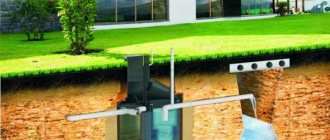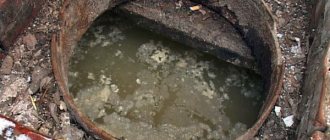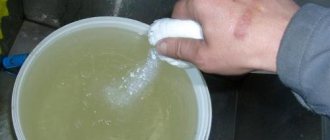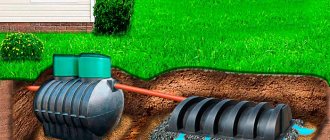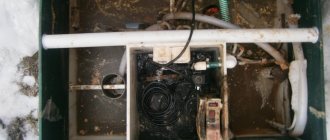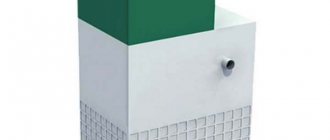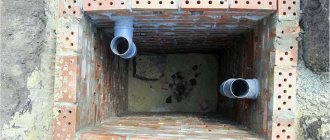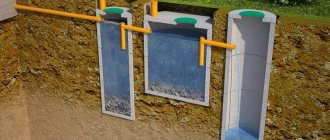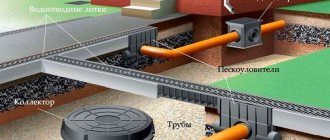When starting to build a house or cottage, you need to immediately think about the issue of landscaping. Most likely, there is no central sewer system in a country village, so local systems will have to be built. At the planning stage, the owner will have to face the problem of choosing a facility for wastewater disposal, that is, a septic tank or an autonomous sewer system must be purchased. Let's figure out which option is better.
Before making a choice, you need to carefully study the features of each of the possible options. Only after assessing the advantages and disadvantages of each of them will it be possible to decide which is better. Let’s figure out what the difference is between a septic tank and an autonomous sewer system and what type of treatment plant should be preferred when improving a particular facility.
A septic tank is cheap, without electricity and reliable!
This opinion is firmly entrenched in the minds of our clients. And this statement is partly true, but not everything is so simple.
Septic tank is cheap
Indeed, if you look first at the cost of a septic tank, and then at the price of an autonomous sewer system, you can see the difference is not in favor of the station. However, do not forget that a septic tank is not a full-fledged treatment device; after it, additional treatment must be organized on the site. And not only sales managers of sewerage products tell us about this, but also SNiP 2.04.03-85 (clause 6.78):
6.78. Septic tanks should be used for mechanical treatment of wastewater entering underground filtration fields, sand and gravel filters, filter trenches and filter wells.
Even the most inexpensive method of post-treatment - an infiltration well - costs 12,500 rubles, excluding the cost of crushed stone. Crushed stone will cost an additional 4,500 rubles per cubic meter. Add all this to the cost of the sump. If you consider the installation of a turnkey septic tank with filtration fields or a biofilter, it turns out even more expensive.
A septic tank does not require electricity
If you have filter soil (sand) and a low groundwater level on your site, then yes. When the site is located on clay soil or on soil with a high groundwater level, then only a biofilter with an electric pump for removing purified water is suitable as a post-treatment for a septic tank. In this case, the energy independence of the system is lost.
For a dacha, a septic tank is more suitable than an autonomous sewer system
Whether you have a dacha or a country house, it doesn’t matter when choosing the type of sewer system. The type of soil is important. If the soil is non-filtering or weakly filtering (loam), then the post-treatment will not work and at the slightest discharge the sedimentation tank will flood.
Septic tank is reliable
All overflows in the septic tank are gravity-fed and at first glance it seems that there is nothing to break. This is true in the following cases:
- Septic tank without defects.
- Installed according to all rules.
Otherwise this happens.
Fig.1. The clay squeezed the septic tank and deformed it
Septic tank - install it and forget it
The passports of factory septic tanks indicate that the sump tank needs to be serviced once every 1-2 years, but there are also stories on the Internet about maintenance once every 5 years. Is this possible? If you come to your dacha and use the sewer system only on summer and spring weekends (and not every weekend), then yes, it’s possible. But if you live in your country house permanently or even seasonally for six months, then you will have to service the septic tank more often.
And if the septic tank is not maintained, the quality of cleaning will deteriorate, and as a result, the filter elements will silt up, which will then have to be dug up.
Bottom line: A septic tank is not for everyone
A septic tank can really be an inexpensive and very convenient solution for organizing sewerage on a site. And yet it is not suitable for everyone. Therefore, the statement that a septic tank is the only true, cheapest and most reliable treatment facility is untrue and a myth.
Of course, this does not prevent some people who want to save money at all costs from ignoring warnings and hoping for a miracle, but you saw the consequences of this in Figure 1.
Septic tank sewer system
This type of sewerage system is a settling tank system, with further partial disposal of wastewater. A septic tank consists of three or four containers connected by a common line through which used domestic water flows sequentially.
From the main house sewer pipe, wastewater enters the first chamber of the septic tank, where primary sedimentation occurs. Solid and heavy organic compounds precipitate. A process of fermentation and partial disintegration occurs. Flowing into the second chamber of the septic tank, the process is repeated, filtration occurs due to sediment. After the third (sometimes fourth) treatment, wastewater is discharged through the main line into the filtration field system.
Septic tank sewer system
The filtration field is a system of perforated pipes laid in a certain way on a bed of sand and crushed stone for the final purification of wastewater before entering the ground. Waste water seeps through the entire septic tank system and goes into the soil. The field has a size of about 30–40 square meters. m. The pipe system needs to be replaced every 6–7 years. It is also necessary to replace the layer of sand and crushed stone, since the field silts up and the autonomous process of wastewater disposal ceases.
System advantages
The main difference between a septic tank and an autonomous sewer system is the independence of the first system from electricity or other power sources. The drainage, collection and disposal of domestic water occurs due to the mechanical movement of water along sewer lines. The following advantages of the system:
- cheapness;
- ease of installation, the ability to make the system yourself;
- independence from the amount of wastewater.
The septic tank chambers are made of durable plastic with elements of metal fastenings that are not subject to corrosion. The septic unit works well at low temperatures.
This sewer system is installed into homes during construction or over time. During installation, it is necessary to carry out excavation work to install the septic tank (it is dug into the ground), and to install the filtration field. The pipes are laid in the soil on a prepared cushion.
In addition to the sludge system, in the solid layers of sediment, the process of fermentation of microorganisms in the water occurs without access to oxygen. Biological components disintegrate, so natural sediment in the chambers is minimal.
Disadvantages of Septic Treatment
Plastic septic tanks
Dependence on sewerage works. Removal of solid and semi-liquid human waste products occurs through pumping with a sewage disposal machine. Removal occurs depending on the accumulation of septic tank chambers. With intensive use, the number of cleanings can reach up to twice a year. When purchasing a system, both the cubic capacity of the storage chambers and the length of the filtration field lines are taken into account. Choosing a large-volume septic tank will allow you to limit yourself to calling a sewer truck once every two years.
Replace the cleaning field every 6–7 years.
This sewer system is not installed if the house is located on clay soils. With such soil parameters, the process of natural water recycling is impossible. Installation difficulties are possible in the following cases:
- soil heterogeneity;
- horizon changes;
- close location of groundwater.
Possible unpleasant odor. If you do not carry out preventive cleaning work in the septic system, a persistent smell of sewage appears in the area for 2–3 years; in such cases, the septic tank must be replaced.
Possible consequences
An important point when choosing a septic tank or autonomous sewer system. If the residence in the house is not permanent, then it is recommended to choose a septic tank. With such a load of wastewater, this system functions well and does not require additional control. Sewage works can be carried out once every two years.
Water that has been purified by this system according to technical parameters (purification 92–95%) can be used for watering garden crops. When installing a septic tank autonomously without additional filtration fields, water purification will be 75%. This parameter is considered environmentally hazardous; such water cannot be discharged into the ground or used for irrigation or technical needs.
When installing a septic tank, the chambers are often populated with bacteria to quickly process biological components. When installing the structure yourself and assembling it, bacteria can be populated separately; when purchasing a production unit, the system is fully provided with the necessary microorganisms in sufficient volume.
The station is expensive, unreliable, and heavily dependent on electricity
Now let's take a closer look at this stereotype.
The station is expensive
It’s difficult to call a biological treatment station a cheap installation, but in some cases, installing an autonomous sewage system on a site is cheaper than a septic tank with post-treatment. For example, if there is clay on the site. In case of difficult soil conditions, a septic tank requires:
- Sprinkling with cement-sand mixture.
- Anchoring.
- Factory biofilter as a post-treatment.
All this will require additional investments and increases the cost of sewerage significantly.
The station is unreliable
Overflows in most stations are carried out using airlifts (mamut pumps), and there is an opinion that they often become clogged. And the compressors supposedly break down quickly, thanks to which the airlifts operate and the drain is saturated with oxygen. This statement is greatly exaggerated. With regular and proper maintenance of your autonomous sewer system, as well as proper operation of the system, nothing will become clogged or broken.
The station is volatile, and after a short power outage the quality of cleaning suffers
The first statement is true, the second is not. Autonomous sewerage can easily withstand a power outage for 6-8 hours, and the quality of the drainage does not suffer after power supply. Therefore, you can safely install the station in areas where the light periodically goes out.
The station requires frequent maintenance
“By buying a station, you turn into its slave,” this phrase periodically appears on forums dedicated to country life. People are scared by the need for frequent maintenance, saying that the station needs to be washed, cleaned and removed from blockages almost every two months. Of course, this is complete nonsense. If you live permanently in a country house, it is enough to carry out maintenance once every 6 months. For seasonal use – once a year. If you come to your dacha only on weekends in the summer, then once every 1.5 years.
Bottom line: The station is convenient and accessible
Biological treatment stations have become widespread in Russia relatively recently, so there are still a lot of rumors and myths around them. And yet, a more convenient solution for autonomous sewerage in a country house does not currently exist. Especially when the site has difficult soil conditions - and in the Leningrad, Moscow and Sverdlovsk regions such conditions occur in 95% of cases.
Now that we have dispelled the main myths about septic tanks and autonomous sewage systems, we will consider each method of cleaning drainage in a dacha in more detail.
How to choose a design for cleaning
To determine what is best for a summer cottage, you need to consider some factors:
- 1. Type of primer.
- 2. How many people permanently live in the house.
- 3. How many liters of water are consumed per day?
- 4. Temperature changes.
- 5.Frequency of use.
The choice between a septic tank and an autonomous sewer depends on the length of stay in a country house and the number of residents. If this is a seasonal use, then it is better to install a septic tank; if it is a permanent stay, then an autonomous system. Local sewerage is much more efficient than septic tanks; it can also be moved from place to place, but reinstalling septic tanks is impractical.
Application of a septic tank
A septic tank can treat wastewater from a country house, country house or cottage. The volume of the sedimentation tank should be equal to three times the daily flow rate. That is, if two people drain 200 liters of water per day each, then they should purchase a septic tank for 1200 liters (2 people * 200 l * 3 = 1200 l).
A settling tank is usually installed in filtering dry soil. Such soils include sand, sandy loam, and limestone. The groundwater level on the site should be no higher than 2.5 meters. To install a sedimentation tank in clay or in soil with a high groundwater level, it is necessary to purchase an expensive after-treatment system.
Fig.2. The post-treatment system for a septic tank can consist of six biofilter blocks, in this case the total cost of sewerage without taking into account installation reaches 200 thousand rubles.
Suitable for both seasonal cottages and cottages intended for permanent residence.
Which option should I choose?
Thus, it is impossible to say unequivocally which of the proposed options is better. Each option has its own advantages. Therefore, to decide what is best to purchase, you need to answer the following questions:
- what volume of wastewater is generated in the house daily;
- whether the house is used for permanent residence or people come there only occasionally (for example, on weekends);
- what type of soil is on the site and at what level the groundwater is located.
So, if you plan to build a large cottage equipped with several bathrooms, in which the family will live permanently, then it makes sense to purchase an autonomous sewer system.
But before purchasing, you will need to find out how far away the service center that services this brand of VOC is located. This is necessary for timely maintenance and repair of equipment.
If you are choosing a model for a summer house or for a home that will be used only periodically, then it is better to buy a cheaper option for a treatment plant - a regular septic tank.
To decide whether it is better to buy a conventional septic tank or a modern VOC, you need to take a balanced approach to assessing the operating conditions. In some cases, it is more profitable to purchase an autonomous sewer system, while in others it is more advisable to purchase a very ordinary septic tank.
The principle of operation of a septic tank
There are settling tanks:
- Plastic.
- Made from concrete rings.
Both options are popular, but the concrete sump is gradually becoming obsolete, people prefer plastic ones.
They are a cylindrical or rectangular container, divided inside into three chambers. In the first, largest, compartment, water is separated from large debris, suspended matter and fat. In the second and third, the wastewater is purified from smaller particles. Water flows from chamber to chamber by gravity without pumps, making the septic tank a non-volatile device.
According to SNiP, after the septic tank, it is necessary to provide for additional wastewater treatment, since cloudy, bad-smelling water comes out of the sump. For post-treatment, a filter well, underground filtration fields or a factory biofilter are used.
Flow-through septic tanks and what is Shambo sewerage
They consist of several chambers connected to each other by overflow pipes. When solid waste accumulates in the primary tank, it is also necessary to pump it out with a sludge sucker, but this is done much less frequently. One of the representatives of flow-through septic tanks is the Shambo cesspool.
Wastewater enters the first chamber, where heavy fractions settle at the bottom, and light fractions float to the surface and form a film. In the middle part, clarified waste is collected, which, when replenished, flows into the next chamber. After passing through 2-3 sections, the wastewater is purified up to 60%, but at the same time retains an unpleasant odor and requires additional soil treatment. Therefore, from the last container, liquid waste is transported through pipes to the filtration fields. There they undergo soil purification with a layer of crushed stone and sand, and end up in the ground.
It is possible that the last container of the Shambo septic tank is made without a bottom and serves as a filter well. In this case, the lower surface of the septic tank pit is filled with gravel, and rings are installed on top.
The advantage of flow devices is energy independence. They can be used in houses with non-permanent residence and in summer cottages. However, over time (on average from 2 to 5 years), the soil and drainage layers become silted and stop allowing drainage to pass through, which is why it is necessary to change the layer by adding another ring. Therefore, this method of arranging a shambo pit is considered undesirable.
Advantages and disadvantages of a septic tank
| Advantages | Flaws |
| Low price of device and installation. True, this only applies to the sump system plus a filter well/filtration field. However, when installing a septic tank of 3 cubic meters (conventionally, this is 5 users), the difference in price is leveled out. | Can only be installed in dry filter soil. Otherwise, you need to buy a biofilter. This is expensive and the system's energy independence is lost. |
| Non-volatile system. | A sewer truck is required for maintenance. |
| Does not require frequent maintenance - only once every 1-2 years. | According to the passport, a complete replacement of post-treatment is required every 10-15 years. In practice - much more often. |
| Does not require preservation for the winter. | |
| Non-degradable items can be dumped into the septic tank; they do not clog the device and are then easily removed with a sewer. |
Obtaining the necessary documents and permits
Each network has an owner. Centralized sewerage too. Therefore, you first need to find out who owns it, because it is with its owner that you will have to negotiate and cooperate. This could be, for example, Vodokanal, or maybe another organization. For the convenience of the network owner, we will refer to it as Vodokanal in this article.
Having identified the owner, you need to collect and prepare the required documents and carry out preparatory work on the site. Only after this, in the presence of a Vodokanal representative, a legal connection is made. Otherwise, for illegal tapping you will be subject to fines and dismantling of the connection at your expense, plus they may charge money for drainage for 6 months.
If an unauthorized connection to the central sewer system of a private house was made before you purchased it, you should contact Vodokanal. If the connection and insertion are carried out according to the standards, you may not have to disassemble everything. The connection will be arranged, which will cost much less.
To submit an application for connection to the Vodokanal service you need:
- Determine the exact location of connection (insert);
- Draw up a diagram of the supply pipeline for laying;
- Select pipes for it.
Therefore, first you need to find out what type of central sewer network you are going to connect to. It can be separate, when domestic and storm drains each go through their own pipelines. It can be mixed, when the drains flow in one pipe, there is no need to insert two separate branches. The type of sewerage system determines the method of draining water from the site (in one or two mains), as well as the possibility or impossibility of draining storm water. For a separate system, permission for each of the networks is issued separately (all papers and the project). In cases where it is impossible to drain storm water into the central network, it can be purified and used on site, for example, for irrigation or washing. A separate tank will be needed to collect storm water.
Since all financial costs for bringing drains to the point of connection, as well as work on the connection, fall on the shoulders of the developer (the owner of the site), it is reasonable to first make an approximate calculation of costs and think through all measures to reduce them. Perhaps it will be possible to gather like-minded people among neighbors, then costs will decrease. Another measure could be the financial participation of the developer in the modernization project. If Vodokanal makes a positive decision, part of the work will be paid for by the organization.
To avoid difficulties related to the rights of neighbors, you must first agree with them on the construction work near their plots. The consent of the neighbors must be recorded (a free-form document with a list of signatures).
What documents need to be prepared
- First of all, you need to contact surveyors at a company engaged in geodetic examinations and obtain a site plan with a sewerage diagram (usually on a scale of 1:500).
- With the received plan, attaching a copy of the passport, a document on ownership of the property, the owner applies to Vodokanal with an application.
- Vodokanal specialists must issue technical conditions (TS) for the future connection (the response period for the application is 2 weeks).
- It is necessary to develop a connection project completed by the designer based on the specifications and site plan.
- Coordination of this project by specialists: an architect and an expert from Vodokanal.
- The choice of contractor - the owner of the property or the organization that will directly connect the private pipeline branch to the centralized main line. The artist selection is displayed in the document.
- If there are other central networks in the territory where the sewer and stormwater branches will pass, permissions from the network owners to carry out work in their area of responsibility will also be required.
Already from what has been said, it is clear that an accurate project will be needed, agreed upon by several authorities. For most owners of suburban areas or new buildings, it is easier to contact companies that collect and prepare documents to prepare documentation. This is not cheap, however, it saves the site owner from wasting time and making mistakes.
Application of an autonomous sewage system
Installed on site for organizing wastewater treatment of private houses, cottages or mini-hotels. Just like sedimentation tanks, they can operate both year-round and only in the spring-summer period. Although periodic use has its own nuances.
The soil and groundwater level do not matter for autonomous sewerage. What is important is the volume of incoming wastewater, the depth of the drain pipe and the method of discharging clean water.
Fig.5. Forced station with clean water discharge into a ditch. If there is no storm drain on the site, water can be discharged into a reservoir, onto a slope, or accumulated in barrels for irrigation
General information
For a country house, and for any house in principle, it is very important to find an option that will collect, settle, process and clean sewage. These stations not only collect all wastewater in one place, but also recycle it. In the future, the recycled wastewater after processing can be reused, for example, for irrigation, fertilizer, or it is simply process water.
For a more complete picture, we should take a closer look at what a septic tank and autonomous sewage system are. So, a septic tank is an unfinished treatment facility and cannot replace a completely autonomous sewer system. According to its properties, it can act only as part of a treatment plant or be part of an autonomous sewer system. After its use, the purified water must enter the filtration facility.
Reference: A septic tank is a structure for the mechanical treatment of wastewater by settling with anaerobic digestion of sludge
An autonomous sewage system is a system of complex structures that includes a septic tank and biological treatment stations. Which includes a sewer pipeline, inspection wells, and underground filtration structures. If necessary, it can be supplemented with other structures.
Reference: Autonomous sewerage systems are sewerage systems that provide collection, disposal, purification and soil absorption (disposal) of household wastewater from sanitary fixtures of one or more single-family residential buildings, auxiliary or public buildings, or an estate with outbuildings and not connected with sewage systems of other objects.
This is why septic tanks and autonomous sewage systems cannot be compared. Each design can exist, provided it provides comfortable living.
Operating principles of autonomous sewerage
The wastewater treatment at the station occurs thanks to aerobic and anaerobic bacteria. As a result of their vital activity, complex organic compounds break down into simpler ones, the runoff gets rid of harmful substances, is purified and discharged to the ground. Unlike septic tanks, autonomous sewage systems purify water by 98%, which allows it to be immediately discharged into a ditch without additional treatment.
An aeration septic tank can have from three to six chambers. They mix the drainage, clean it and cut off sludge from clean water with its subsequent discharge to the outside. The most important difference between the operating principle of an autonomous sewer system and the operating principle of a septic tank is the participation of aerobic bacteria in wastewater treatment. Oxygen is necessary for their life activity, and in order to saturate the runoff with it, special elements are provided in the station - aerators.
The drain flows from chamber to chamber via airlifts or by gravity.
Autonomous sewer electrics
Pumping of waste from chamber to chamber in stations occurs using compressed air, which is supplied to all elements by one or two compressors. Accordingly, such an installation will not work without electricity.
In stations with forced drainage, a drainage pump is also provided. And to protect all electrics, an alarm is required (only if the compressor is located inside the station).
Important! Most manufacturers do not provide hazard warning lights included. However, he gives it to his clients.
So which is better: a septic tank or a biological treatment station?
The answer to this question is by no means clear-cut. Even despite the above comparison of qualitative characteristics, the recommendations of experts and manufacturers of treatment facilities should be taken into account, as well as based on the letter of the law. In irregularly visited country cottages with frequent lack of electricity, low groundwater or water-permeable soil, it is more rational to use simple septic tanks. However, do not forget that the law prohibits the use of septic tanks within gardens and official environmental zones. In housing construction located in such areas, the installation of only biological treatment stations is permitted!
If a suburban building serves as a place of permanent residence, then it would also be more rational to use an autonomous sewage system with biological treatment. And the slightly higher price of equipment with installation, relative to a septic tank, will pay off in just a couple of years. After all, installation of a septic tank is more expensive and labor-intensive, and subsequent periodic maintenance, including updating the crushed stone bed every few years due to its silting due to low wastewater treatment, adds to the expense item by a significant amount, unlike cone-shaped VOC stations, where The service includes only sewage disposal. Let us remind you that this procedure is necessary approximately once every couple of years, costs on average in the regions about 2,000 rubles and takes no more than half an hour.
When giving preference to a septic tank or biological treatment station, you should evaluate in advance not only the characteristics of the house and site, but also the subsequent periodic costs of maintenance and the purchase of related materials. In any case, both types of structures are better than “birdhouses” and dry closets, and we can always help you make the right choice. Call in St. Petersburg (812) 332-52-40, write by email or use the feedback form below and we will answer all questions.
Advantages and disadvantages of autonomous sewerage
| Advantages | Flaws |
| High degree of wastewater treatment. | Preservation for the winter is necessary in case of seasonal use. |
| Self-service is possible without calling a vacuum cleaner (in most stations). | The compressor needs to be replaced every 5 years. |
| A wide range of stations - from low-productivity to devices for 150-200 people. | Requires maintenance every 6 months for constant use and every 12 months for seasonal use. |
| Possibility to use the station both permanently and seasonally. | Relatively high price. |
| Takes up little space on the site. | They consume electricity on average 1.5 kW/day. In rubles – 5 rubles/day or 150 rubles/month. |
| Suitable for any soil. | |
| Does not require anchoring. |
Biological treatment station: features of use
Everything ingenious is simple! Local treatment facilities in the form of cone-shaped biological treatment stations are an almost entirely mechanical complex built on aerobic technology, which involves the use of only one simple electronic mechanism in the system - a compressor. In such stations there is simply nothing to break. And the installation and operation of an autonomous cone-shaped sewer system is absolutely simple and fully complies with the “bury and forget” principle!
A constant supply of oxygen to the system ensures the reproduction and activity of aerobic microorganisms (bacteria) involved in the process of purification and disinfection of wastewater. The purified water leaves the station by gravity, and the residue in the form of sludge that accumulates after complete processing is easily removed from the easily accessible bottom of the station using a sludge pump (sewage disposal) approximately once every two years. That's all!
The devices, designed to serve from two to three to 20 users, are small in weight and dimensions and comparable to household refrigerators. The energy consumption for the operation of such VOCs is, as a rule, insignificant and does not exceed the consumption of a standard indoor chandelier, and the level of wastewater treatment reaches 98%, which makes it possible to subsequently use purified water for watering non-fertile plants and other technical needs on the farm.
Positive qualities of a biological treatment plant:
- quality of liquid waste treatment – up to 98%;
- no purchase of bacteria required;
- minimum occupied area on the site;
- operation of the station with high groundwater;
- absence of odors and contamination of the territory;
- does not require constant maintenance, only sewage cleaning approximately once every 2 years;
- the possibility of placing the station under asphalt or tiles in the parking lot;
- the possibility of installing additional direct inputs from any side;
- simple installation and configuration of equipment is available to a team of 2 people or more.
Operational disadvantages:
- A constant supply of electricity is required, only short-term outages are permissible.
Service
Central sewerage is a constant expense of money. Moreover, first of all, this is not a subscription fee (which, by the way, is also quite considerable), but a kind of “microtransaction”, i.e. constant small payments for various services. And you have to pay for everything. For example, for fixing problems that happen very often.
What does a septic tank offer us? It requires almost no maintenance (only annual sludge removal is on the list of necessary operations) and, subject to operating conditions, does not break down or begin to work less efficiently. A septic tank does not need the services of a septic tank - this is already a thing of the past.
Moreover, septic tank service costs very little, and during the warranty period it is completely free.
